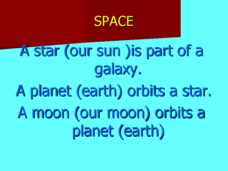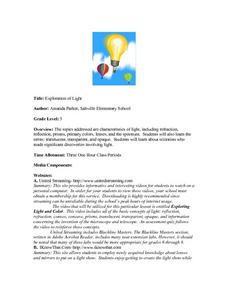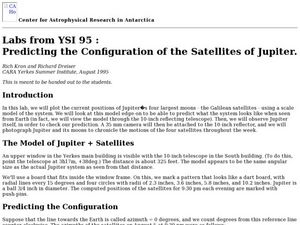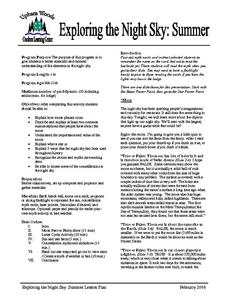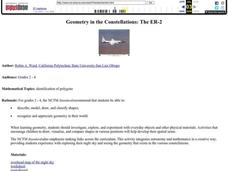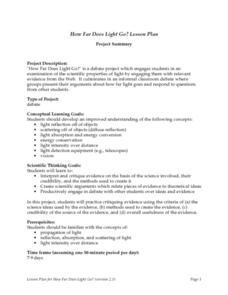Curated OER
Too Bright at Night?
Students reflect upon the causes and effects of light pollution in the night skies. First, they read articles provided and then do worksheets that are provided. They work in groups to discuss their conclusions.
Rice University
College Physics for AP® Courses
Take a look at an organized physics course. The 34-section electronic textbook covers material in AP® Physics 1 and 2. Teachers use the text to supplement lectures and have the class work through the labs. Each section contains...
Curated OER
Lenses and Mirrors
Students investigate lenses and mirrors showing how they bend and reflect light waves.
Curated OER
Basic Space
Three basic slides cover information about light years and how images of space are viewed. Some facts about light years are given and then a labeled diagram of a telescope is shown. One basic slide is included with definitions of...
Curated OER
Exploration of Light
Fifth graders observe the video, Exploring Light and Color. They access a website to create their own light show. They conduct lab experiments to investigate refraction, reflection,and other light-related topics.
Curated OER
Cosmic Rays
Students study cosmic rays and the energy behind them. In this atmospheric lesson students complete a cosmic ray telescope project.
Curated OER
Radiation from Space
In this radiation worksheet, students review the different types of radiation waves that come from space and the different telescopes used to detect this radiation. This worksheet has 17 true or false questions.
Curated OER
5th Grade Science
In this science worksheet, 5th graders complete multiple choice questions about flight, astronomers, measurement, temperature, and more. Students complete 25 questions.
Curated OER
Light - Stop Faking It!
This well-designed presentation covers many important aspects of the science behind light. In it, pupils view slides that have a lot of the important vocabulary associated with science, slides of famous scientists who made important...
EngageNY
The Definition of a Parabola
Put together the pieces and model a parabola. Learners work through several examples to develop an understanding of a parabola graphically and algebraically.
It's About Time
Curved Mirrors
Discover concave and convex mirrors using a laser light. Scholars experiment with real and virtual images before reading a handout and completing homework questions. Included extensions greatly benefit learners, so take...
Curated OER
Predicting the Configuration of the Satellites of Jupiter
Young scholars plot the positions of the planet Jupiter while predicting what the configuration system looks like from Earth. In this configuration of satellites lesson, students photograph Jupiter and its moons to record the...
Curated OER
Exploring the Night Sky: Summer
Learners explain how moon phases occur. They describe and explain at least two common misconceptions that people have about the moon. Students explain what a star is. They explain 3 ways that the night sky has been used throughout history.
Curated OER
The Vocabulary of Space
Students build their knowledge and understanding of vocabulary related to space. In this space instructional activity, students discuss four categories of words and phrases related to space.
Curated OER
Geometry in the Constellations: The ER-2
Students discuss reasons to record the location of stars. They view a picture of the night sky, and discuss constellations. Students complete a worksheet of the various shapes they see in the constellations.
Curated OER
Wax On, Wane Off
Students explore the Earth's only natural sattelite, the moon. They view a demonstration using tennis balls of the waxing crescent moon, waxing gibbous moon and a lunar eclipse.
Curated OER
Six Billion and Beyond
Students consider the idea of a world with Six Billion people and subsequent results and ramifications. Then students will gather data regarding the state of these diverse nations and then create a presentation as a culminating activity.
Curated OER
Finding Fibonacci
Students study and apply the Fibonacci numbers and how they occur in nature. Students solve problems using the Fibonacci numbers.
Curated OER
Exploring the Night Sky: Fall/Winter
Students explain how moon phases occur. They explain three ways that the night sky has been used through history. Students locate some of the constellations in the night sky. They discuss stories and myths surrounding stars.
Curated OER
How Far Does Light Go?
Students engage in research from the internet to search for facts concerning the scientific properties of light. The information is collected in order to gather evidence for a classroom debate. The debate includes a question and answer...
Curated OER
Blast's Cosmic Carnival
Students, after analyzing the history of a concentrator, model how a Genesis spacecraft concentrator works by playing a game. In groups of three or four, after being given materials to work with, are challenged to roll the rubber balls...
PBS
Pbs Learning Media: The Beginnings of the Telescope
This animated essay from the NOVA Web site examines the design of Galileo's refracting telescope and Sir Isaac Newton's reflecting telescope.
Space Telescope Science Institute
Amazing Space: Telescopes From the Ground Up
Students can investigate the historical development of six different telescopes. The technical aspects of different telescopes are also presented.
University of Chicago
Telescopes at Yerkes Observatory / Virtual Tour
This site describes the difference between reflective and refractive telescopes and includes a virtual tour of Yerkes Observatory which houses the largest refracting telescope in the world.





